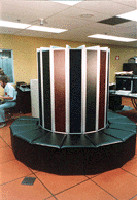In the mid-to-late 1970’s, the Cray-1 was the fastest computer in the world, with a clock speed of 12.5 ns (80 MHz), computational rates of 138 million floating-point operations per second (MFLOPS) during sustained periods, and 250 MFLOPS in short bursts. Up until that time, there has been no other computer like it. The Cray-1 had spawned a new class of computers called the “supercomputer,” a computer highly optimized for computational speed, and is typically used for its mega number-crunching capabilities. Considered to be the first supercomputer, Cray Research’s Cray-1 was unveiled in 1976 by Seymour R. Cray, its inventor and chief design architect. Early versions weighed over five tons, featured the equivalent of 8 MB of RAM, and cost about $9 million.
In 1985 the Cray-2 was introduced, which could do 1.9 gigaflops (1.9 billion flops), operated at 244 MHz, had the equivalent of 2GB of RAM, and cost about $12 million.
For comparison, a typical PC bought in 2000 or 2001 uses a Pentium 4 processor with a clock speed of 1.5 GHz, benchmarks at around 1.8 Gflops, probably cost under $2,000, and fits under your desk. In short, it’s the rough equivalent of a 1985 supercomputer for one-six thousandth the cost.
Today’s typical PC is even faster, but so is today’s typical supercomputer.
Here are the current Top 500 Supercomputer sites.
IBM continues to establish itself as the dominant vendor of supercomputers with now more than half of the list (51.8 percent) carrying its label.
At the top spot, IBM’s BlueGene/L consumes 2.5 megawatts to run and cool the computer and takes up 2,500 square feet of floor space.
There’s a Cray at the #10 spot.
The last system (#500) in June 2005 has about the same computing power as ALL 500 systems combined, when the list was first created 13 years ago in June 1993.
The U.S is clearly the leading consumer of high-performance computing systems with 294 of the 500 systems installed there. Europe is still ahead of Asia, with 114 systems installed. In Europe, Germany claimed the No. 1 spot from UK again, with 40 systems compared to 32.
However, without special modifications, software doesn’t run any faster on a supercomputer than it would on a personal computer. Every day private and public analysts confront huge amounts of data from which to draw conclusions, find relationships and discover hidden trends. Visualization analytics tools let users “discover the unexpected”.
Supercomputer gallery.

